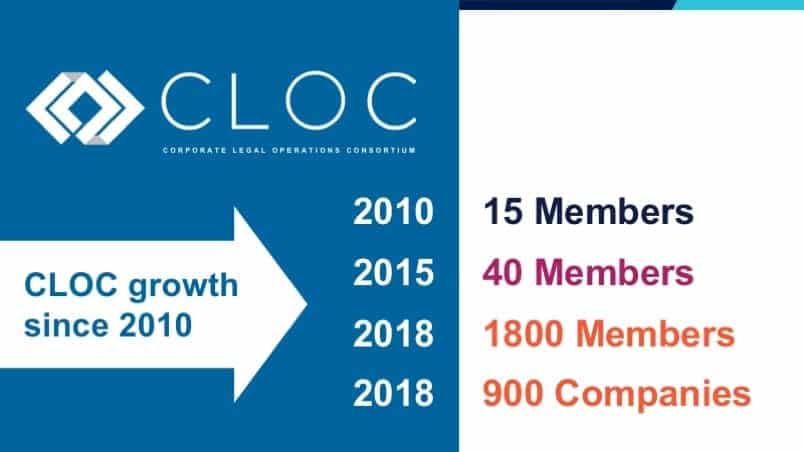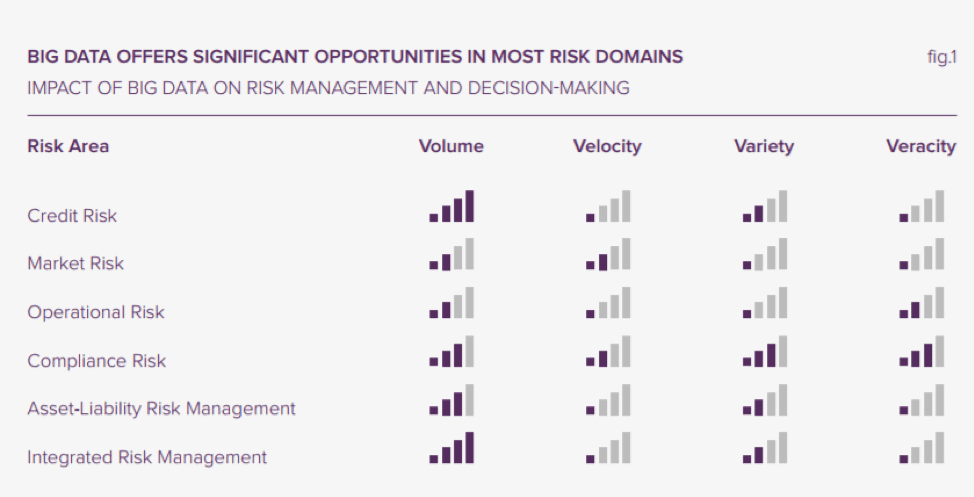7 Expert Legal Operations Predictions for 2019
What’s ahead for Legal Operations professionals and other legal tech users in this new year? The past few have already seen intense change, but our expert contributors have definite predictions on how transformation will stay the order of the day in 2019.
 We won’t forecast more growth in Legal Operations, since that’s not very visionary: It doesn’t take a crystal ball to predict the Legal Rising trend will continue, as we and other observers have repeatedly noted. The growth of the Corporate Legal Operations Consortium (CLOC) over the past several years is clear evidence of that. Perhaps even more significant has been CLOC’s surprisingly swift and successful expansion into the APAC and EMEA regions.
We won’t forecast more growth in Legal Operations, since that’s not very visionary: It doesn’t take a crystal ball to predict the Legal Rising trend will continue, as we and other observers have repeatedly noted. The growth of the Corporate Legal Operations Consortium (CLOC) over the past several years is clear evidence of that. Perhaps even more significant has been CLOC’s surprisingly swift and successful expansion into the APAC and EMEA regions.
There’s a global recognition that in-house legal departments need to function with greater efficiency and agility, and find ways to better engage with the rest of the enterprise in order to address a new universe of risk and complexity.
Legal Operations is primary to that transformation, and is wired into many of the other legal tech trends we touch on below that will take on greater prominence as we roll toward 2020.
 From Judith Tigner, Senior Vice President, Client Success, Mitratech:
From Judith Tigner, Senior Vice President, Client Success, Mitratech:
Outside counsel spend will keep rising (as will the need to manage it)
Spending on outside counsel will once again be on the rise in 2019, as corporations add as much as $5 billion to outside counsel budgets over 2018-19, driven by cybersecurity and merger & acquisition demands, among other factors. Optimizing outside spend while improving collaboration and outcomes will be more important than ever for in-house legal departments.
The net-net of this for Legal Operations teams? It will become more important than ever to have tools and best practices in place that allow them to extract the greatest possible value from outside spend.
 From Kevin Clem, Managing Director and Law Department Consulting Practice Lead, HBR Consulting:
From Kevin Clem, Managing Director and Law Department Consulting Practice Lead, HBR Consulting:
More leading law firms will add Legal Operations leaders
Over the past few years, there have been a few high profile law firms who have hired operations leaders that had prior experience as in-house Legal Operations leaders. As the significant growth of Legal Operations has proven that this “movement” is here to stay (58% of law departments now have a dedicated legal ops manager per the 2018 HBR Law Department Survey), I expect to see more leading law firms adding roles for legal operations leaders at the firm.
This would enable those firms to gain a better understanding of the “voice of the customer” and bring those professionals into data-driven and technology-enabled discussions with their in-house Legal Operations counterparts. No longer in a “wait and see” mode, leading law firms in 2019 will invest more time and attention on understanding the rapid growth of Legal Operations and making investments to align the firm strategy and operations with the needs and direction of their clients.
 From Eyal Iffergan, Managing Principal, Hyperion Global Partners:
From Eyal Iffergan, Managing Principal, Hyperion Global Partners:
An expanded use of analytics
Law departments will grow and mature to better understand and embrace their role within the larger business context, expanding their use and integration of decision support analytics to tell better stories. Operational initiatives we expect to see in 2019 include specifically:
- Analyze spend against outcomes (including scenario testing)
- Quantify hard-dollar ROI from the use of ELM technologies
- Assess the capacity and impact of legal services to business partners
- Interpret common legal work profiles and the catalysts that drive it
- Benchmark in-house and outside counsel performance
- Build more meaningful and engaging operational visualizations
 From Steven O’Donnell, Head of Product Marketing – Legal Operations, Mitratech:
From Steven O’Donnell, Head of Product Marketing – Legal Operations, Mitratech:
The role of the General Counsel will continue to change
For the past 30 years, Mitratech has provided the technology that the Office of the General Counsel and the legal department use to manage their core legal processes and operations. That history gives us considerable insight into the evolution of the role of the General Counsel (GC).
The GC’s role historically was centered on the management of outside counsel relationships while also acting as a legal advisor to the rest of the company. For decades, legal departments aspired to become less reactive and more predictable, while being better partners with the rest of the organization. However, over the past decade, the role of the GC has been shifting and expanding, and what started as a gradual change has turned into a real force that is driving our product strategy.
The shift in the GC’s role is driven by both internal and external forces which include the public, which is more likely than ever to scrutinize corporate activity; regulators whose expectations include proactive compliance programs; and employees whose individual actions put both revenue and reputation at risk.
Today the General Counsel is frequently responsible for Risk and Compliance as well. What was a legal advisor for the corporation is now a strategic advisor to the CEO and Board of Directors:
- A 2016 NYSE Governance Services Survey conducted by BarkerGilmore showed that 97% of US corporate executive officers and directors expect the GC to be part of the executive management team by the year 2020, an increase of 16% from 10 years ago. This same survey shows that the number of GC’s acting as the Chief Risk Officer is expected to more than double by 2020. Our opinion? These insights still hold true.
- According to the Global Legal Post report The Law Department of the Future and General Counsel Excellence, more than 50% of GC’s now identify their function as something other than managing the legal department. In fact, almost one third themselves as a stakeholder in business decisions, and 30% see compliance as the biggest threat to the business.
As the role of the GC continues to evolve into a strategic risk manager for the organization, our technology needs to continue to extend with it in order to remain the trusted technology partner of corporate legal professionals, regardless of their practice areas.
 From Chris Kraft, Chief Growth Officer, Mitratech:
From Chris Kraft, Chief Growth Officer, Mitratech:
The cost and complexity of Risk Management will keep growing
Expanding global business operations, demanding regulatory environments, and multifaceted legal matters are changing the way business leaders look at opportunities and manage enterprise risk. The operational concerns of corporations, along with legal requirements and regulatory changes, create complex, overlapping obligations that our clients are forced to manage. Passive management—or worse, reactive response—is no longer an option.
The risks and resulting costs of complacency, both in terms of opportunities unrealized and the negative impact on profitability, can be too damaging. One only needs to look at recent examples of Volkswagen, whose emissions scandal could have resulted in $87B in damages and losses in a worst-case scenario, according to Credit Suisse estimates, or the Equifax breach of 143 million accounts, to understand the scale of risk management today and how it can impact every part of an organization. These elements intersect to create a complexity unprecedented in our corporate history, and we only see this challenge growing over the next 5 years.
To address this challenge, companies are seriously considering an integrated risk management (IRM) approach, especially since69% of organizations are not confident their current risk management policies and practices will meet their future needs. This was one of the insights in Gartner’s Inaugural Magic Quadrant for IRM, the analyst’s first-ever survey of technology providers (including Mitratech) attempting to help organizations realize the benefits of IRM.
 From Brian McGovern, Executive Director, Strategic Programs, Mitratech:
From Brian McGovern, Executive Director, Strategic Programs, Mitratech:
Increasing acknowledgement of Big Data as an asset in risk management
The promise of taking large datasets and revealing patterns, trends, and associations, especially related to interactions and decision making is now being realized. Risk management is an area that obviously benefits from this form of analysis because of the sheer number of factors and decisions made throughout the risk management lifecycle. Increasingly, there’s a desire to merge internal and external datasets to improve the decision-making process.
According to industry consultant Advantage Reply (see below), the opportunity to utilize Big Data for Integrated Risk Management is extremely high. Although we’re still in the early stages of this market shift, we understand the importance of this trend as an influencer on strategy.

Within our own client base, we’re currently seeing rising demand for predictive analytics and technology-suggested recommendations in areas where legal and compliance professionals are less apt to make optimal selections. Outside counsel selection and the decision to litigate vs settle are common areas where predictive analytics are desired.
 From Kirk Sadler, Director of Product Management, Mitratech:
From Kirk Sadler, Director of Product Management, Mitratech:
Legal tech user expectations will keep evolving
Mitratech has a total user community of over 500,000, and it keeps growing rapidly. That gives us an excellent source of feedback and insight into what users want and expect, as you might imagine. As a long-term technology provider, we know user adoption is key to the realization of the operational efficiency and ROI that software can bring. That’s why we employ dedicated UI/UIX expertise within our product management team, continually researching how end users view their user experiences.
According to primary research we conducted in 2017, user experience was the most important customer purchasing criterion among mid-market decision-makers when it came to enterprise legal management (ELM) solutions. In fact, user experience ranked as being just as important a factor as price.
Beyond this? User expectations have evolved – and will continue to evolve – with regard to delivery and devices. The market acceptance of hosted SaaS solutions for legal and risk management areas developed more slowly than other technology segments because of the sensitivity of the information and data being hosted. But that fear is quickly dissipating. The majority of our sales pipeline now prefers hosting sensitive data in the Cloud. Modern technology users demand a modern experience, so the expectation of mobile optimization, applications, and workflows that foster ease of use is greatly impacting product strategy.
This shift in legal industry user expectations will stay in force in 2019, and may even accelerate as more Legal Operations professionals and attorneys become not just comfortable with innovations being brought to their door, but actively drive innovation forward in dynamic new ways.
Other resources on Legal Operations and ELM you might find interesting:



